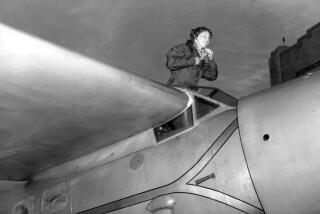Mother Hopeful as Expert Says Man in Photo Is MIA Pilot : Vietnam War: Gladys Fleckenstein is expected to play a key role in Senate hearings on the government’s efforts to locate missing servicemen.
- Share via
One Sunday afternoon last July, Gladys Fleckenstein sat in a friend’s living room gazing intently at a color photograph of a paunchy, middle-aged man standing before a grass-roofed building, right arm around an Asian woman.
Though she had not seen him in nearly 23 years, Fleckenstein was certain she recognized the man. She was sure he was her son, Lt. Cmdr. Larry J. Stevens, a Navy jet pilot from Canoga Park. He had been declared missing in action after being shot down during an attack on a North Vietnamese truck convoy on Valentine’s Day, 1969.
“I thought: ‘My God, he is alive,’ ” Fleckenstein of Big Bear Lake said Monday. “I’ve known he’s alive all these years, just knew it. But now I’ve got the proof. I’ve got the real proof.”
Fleckenstein’s maternal certainty got some scientific bolstering over the weekend when a Colorado State University forensic anthropology expert said he had positively identified the man in the photo as Stevens by comparing it with a black-and-white photo of the pilot taken the year he disappeared.
“It is one and the same person,” Michael Charney, 80, a specialist in identifying human remains and people in photos, said Monday.
Stevens is among the 2,200 U.S. servicemen still listed as missing in action from the Vietnam War.
Charney’s comments came as the U.S. Senate prepared to open a series of hearings beginning today on the adequacy of the U.S. government’s efforts to locate and retrieve U.S. servicemen missing in Southeast Asia.
The Senate Select Committee for POW/MIA Affairs was formed after the release in July of a series of photos purportedly showing American POWs, including Stevens. Fleckenstein, 70, is scheduled to testify before the committee Thursday along with a Tennessee circuit court judge who obtained the purported new photo of Stevens with the aid of his bailiff, a former captain in the Royal Laotian Army.
The judge, Hamilton Gayden, said Monday that the photo of Stevens was taken last year at a camp for American prisoners on Savoy Island in Cam Ranh Bay in Vietnam, site of a giant U.S. military installation during the Vietnam War.
The photo clearly shows a middle-aged Caucasian man wearing glasses, a light-colored polo shirt, pants and a wristwatch. If alive, Stevens would be 49 next month.
Gayden said that the photo was shot by the Vietnamese prison commander and that the woman in the picture is the commander’s wife. Gayden said the photo was smuggled out of Vietnam by a Laotian businessman and mailed to his bailiff from Thailand.
Navy Cmdr. Greg Hartung, a Pentagon spokesman, said Defense Department authorities plan to conduct their own comparison of the photos but have not yet done so.
“We don’t know who’s in it, and the investigation is ongoing,” he said.
Frances Zwenig, the Senate committee’s staff director, said Fleckenstein and Gayden are expected to play key roles in the hearings, providing “case-study” examples of the government’s handling of MIA cases in which there is some documentary evidence.
Also scheduled to testify are relatives of other MIAs, Defense Secretary Dick Cheney and Bill Bell, chief of the U.S. government’s POW/MIA office in the Vietnamese capital, Hanoi.
Fleckenstein said she plans to “pound on the government” to increase its efforts to locate American servicemen that relatives believe are still held by Hanoi and get them released.
“I’m going to tell them, ‘I want you to go in and bring my son home, and the rest of the men. I know he’s alive, and you know he’s alive,’ ” she said.
Charney said a mechanical engineer at Colorado State used a computer scanner to produce outlines of the facial features of the men in the color and black-and-white photos. Charney then superimposed one image onto the other and they matched within 1/100 of an inch, he said.
“He looks very healthy and overfed, as though he’s enjoying himself,” said Charney of Stevens. “But his face is not grinning. It’s a grimace.
“How can I tell it’s not a fake, that it wasn’t taken at the Bronx Zoo? I don’t know. That’s not my job. That’s the job of the photographer.”
Charney, who directs Colorado State’s forensics laboratory, has worked on behalf of MIA families to double-check identifications of their next of kin’s remains made by Army specialists.
Ellis R. Kerley, a past president of the American Academy of Forensic Sciences, described Charney as “a reputable scientist.”
“Is he biased? Possibly a little. Most of us are, a little. I think he tries his best to be objective,” said Kerley, who once headed the Army’s Central Identification Laboratory in Hawaii, an installation Charney has criticized in the past.
The Pentagon’s Hartung said he was unaware of Charney’s reputation and had no comment on his credibility.
Gayden, a POW/MIA activist, said he believes that since the photo was taken in September, 1990, Stevens and other prisoners from Savoy Island have been moved to another prison camp near the Laos-Vietnam border.
MIA activists believe Stevens is among three men purported to be American MIAs in a blurry photograph that caused a nationwide stir when it was widely published in July. But Pentagon investigators have said that photograph was one of five obtained from a single source known to have fabricated such information in the past.
Hartung said Pentagon investigators believe four of the five photos were copied from Soviet magazines widely available in Southeast Asia and doctored. However, the remaining photo--which depicts the three purported Americans--has not been established as authentic or fake, he said.
More to Read
Sign up for Essential California
The most important California stories and recommendations in your inbox every morning.
You may occasionally receive promotional content from the Los Angeles Times.










